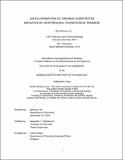(De)fluorination of Organic Substrates Mediated by Nontrigonal Phosphorus Triamide
Author(s)
Lim, Soohyun
DownloadThesis PDF (32.43Mb)
Advisor
Radosevich, Alexander T.
Terms of use
Metadata
Show full item recordAbstract
Due to its high electronegativity and small size, fluorine atoms form the strongest single bond to carbon, and impart unique physical, chemical, and physiological properties to organic compounds. Therefore, the number of industrially synthesized products containing fluorine has seen a substantial increase in recent decades. The strategies to access organofluorine compounds include two opposite approaches: 1) (nucleophilic, electrophilic, or radical) fluorination, and 2) selective defluorination of polyfluorinated substrates. Both creating and breaking C−F bonds in selective manners are of great importance, and present challenges of their own. The work herein describes chemical transformations incorporating the cleavage or formation of the C−F bonds mediated by nontrigonal phosphorus triamide. Thanks to the enhanced biphilicity resulting from geometric deformation, the Cs-symmetric tricoordinate phosphorus compound can activate strong covalent bonds.
At the outset, Chapter 1 reviews the existing literature on (de)fluorinative chemical transformations focused on deoxyfluorination and hydrodefluorination, as well as examples of nontrigonal tricoordinate phosphorus compounds and their characteristic reactivity. Combining the two approaches, Chapters 2 and 3 introduce method development for accessing organofluorine compounds using a butterfly-shaped phosphorus triamide as a bond activator. In Chapter 2, the method for deoxyfluorination of aliphatic alcohol substrates via O−H activation by phosphorus, catalyzed by borane Lewis acids, is detailed. The scope of the method covers tertiary alkyl fluorides, which are generally challenging targets, selectively yielding stereoinversion products for chiral substrates. Chapter 3 reports a closed P(III)/P(V) synthetic cycle for the hydrodefluorination of polyfluoroarene substrates that consists of C−F oxidative addition, F-to-H ligand metathesis, and C−H reductive elimination. The overall sequence is analogous to transition metal-catalyzed aryl cross-coupling reactions. Taken together, the methods described in this dissertation highlight the potential of nontrigonal phosphorus compounds as a mediator for the manipulation of strong covalent bonds, useful in the development of synthetic methods that complement existing ones.
Date issued
2025-02Department
Massachusetts Institute of Technology. Department of ChemistryPublisher
Massachusetts Institute of Technology